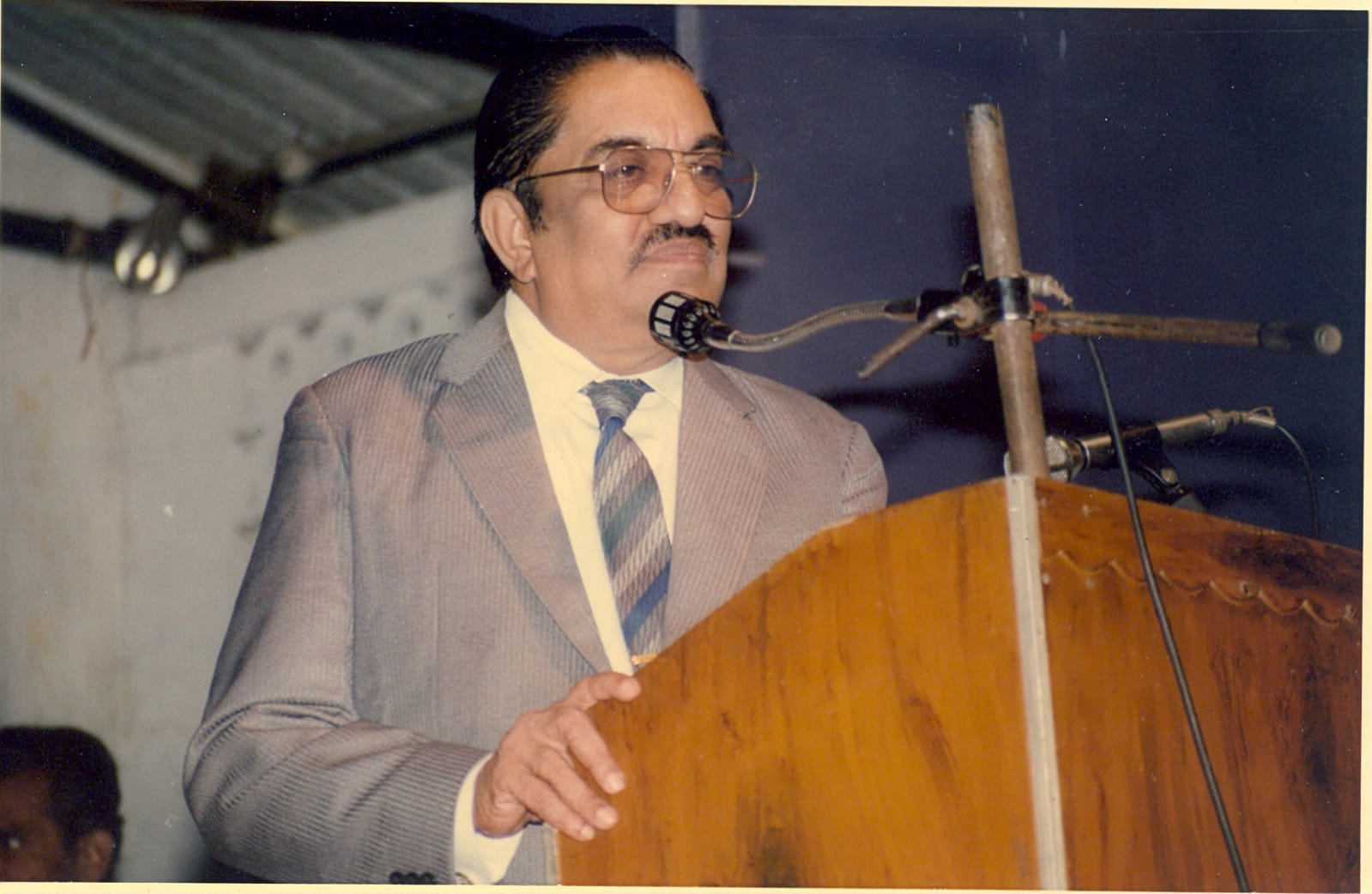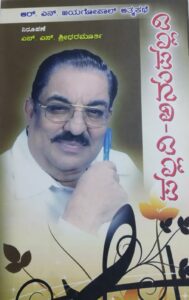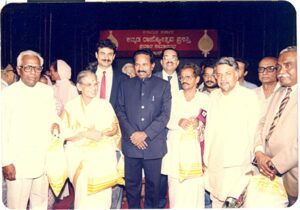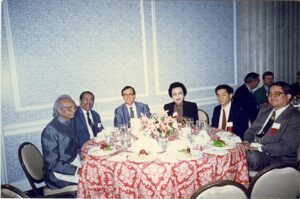On the occasion of Jayagopal's 15th death anniversary, NS Sreedhara Murthy gives us a comprehensive overview of the life and work of 20th-century of one of Kannada cinema's multifaceted and and enterprising talents.

RN Jayagopal giving a speech in his capacity as the district governor of Lions Clubs (NS Sreedhara Murthy)
RN Jayagopal was an indivisible part of my life for not one or two but 20 years.
In the last 10 years of his life particularly, my day began by talking to him and ended the same way. Either he would phone me or I would phone him.

The cover page of Jayagopal’s autobiography, put together by the author (NS Sreedhara Murthy)
After I began putting together his autobiography, our relationship became even closer. As he continued to write and send more information my way, the autobiography too continued to grow larger and larger.
I remember once sitting together and discussing everything with him. By my estimate, he got me to write at least 550 pages.
Eventually, all this writing took the form of a 288-page book titled ‘Pallavi-Anupallavi’.
We had discussed bringing out a second part. But fate had other plans.
It took a mere two months for RN Jayagopal, who had seemed as fit as a fiddle, to turn violently ill and pass on.
First diagnosed with throat cancer, he was treated for it using chemotherapy and came to Bengaluru for the shooting of the ‘Sita Swayamvara’ portion of his ambitious Kannada serial, ‘Ramayana’.
It was during this that he had a paralytic stroke. Just 15 days later, on 19 May 2008, a heart attack took him away, leaving us with a host of memories.
RN Jayagopal, who wrote 1,680 melodious lyric songs for Kannada films, also wrote the screenplay for 123 films and directed eight films. He was also responsible for beginning the age of the TV “mega serial” in Kannada with ‘Janani’; he would end up directing 22 serials in total.
He started the school ‘Vidya-Vinaya-Vinoda’ for the Kannadigas of Chennai and administered it ably for 36 years. The founder of the ‘Chennai Kannada Koota’, he was a leading figure in the fight for the rights of cinema songwriters and was even the national vice-president of the organisation, IPRC, set up for this purpose.

At the Karnataka Rajyotsava award ceremony in 1993 (RNJ is standing behind Veerappa Moily, the then CM) (NS Sreedhara Murthy)
He also has the distinction of representing India in four editions of the ‘World Lyric Writers Conference’.
As one of the very few people to receive both the highest civil honour given by the Karnataka government (Rajyotsava Prashasti) and the highest civil honour given by the Tamil Nadu government (Kalaimamani), RN Jayagopal acted as a bridge between the two states and languages.
Jayagopal’s father, R Nagendra Rao, is commonly considered the Bhishma Pitamaha (~grand old man) of Kannada cinema. Besides being one of the producers of ‘Sati Sulochana’, the first “talking picture” in Kannada, Nagendra Rao also played the part of Ravana in the film and was its music director.
Jayagopal’s mother, Ratnabai, was the first woman to win the gold medal in post-graduate studies from the University of Mysore. The Nagendra Rao-Ratnabai couple had four children, all boys.
The eldest among them, Guruprasad became an engineer and was one of the main architects of the Bhakhra-Nangal dam. Jayagopal’s other two older brothers also became involved in cinema; Krishnaprasad became a cinematographer and Sudarshan became an actor.
When Jayagopal was a boy of 5, he contracted diphtheria. At the time, diphtheria was a disease with a difficult treatment regime. Consequently, Jayagopal did not attend school until the 5th standard.
However, his mother gave her youngest son a good education at home, introducing him to both Kannada and English literature.
As a result, by the time he began high school, Jayagopal had read the literature of Charles Dickens, Tolstoy, and Thomas Hardy in English and Kannada literature from Pampa all the way up to Kuvempu. In later years, this early education would serve as the necessary base for his career as a songwriter.
Jayagopal learnt music under the tutelage of Parameshwara Vadyar. He also learnt the violin from Ballari Bhimasenachar and became proficient enough to act as an accompanist to several senior vocalists.
When he was studying at Central College, he began a ‘Science Society’ and got the Nobel Prize-winning scientist, Dr CV Raman, to inaugurate it.
He also made a name for himself in cricket as a talented batsman. He often opened the innings with AV Jayaprakash, who would later go on to become a well-known Ranji trophy batsman and, later, an ICC umpire.
When studying in Central College, Jayagopal’s teachers included Kannada’s famous litterateurs, GP Rajaratnam and V Seetharamaiah. Their capable teaching increased his interest in literature.
As Nagendra Rao was keen to open a studio of his own, he asked Jayagopal to take up a diploma course in Sound Engineering after finishing his PUC. The diploma course that started with 30 students entered its final year with just one student — Jayagopal. With his training, Jayagopal showed every sign of becoming an excellent sound engineer. But destiny had other plans for him.
GP Rajaratnam, Kannada’s famous ‘Sahitya Parichaaraka (~Literary Preacher)’, used to encourage his students’ creativity by annually publishing a booklet comprising their poems. The poem Jayagopal wrote for this, titled ‘Neeniddarenu Hattira, Eshtondu Naduve Antara (So what if you’re close by, there’s so much space between)’ completely changed the direction of his life.
Rajaratnam, who was very impressed by the poem, spoke glowingly about it to Nagendra Rao when they happened to meet. Having listened to the praise of such a senior litterateur, Nagendra Rao, who at the time was the producer-director of ‘Premada Putri’ handed over the responsibility of writing the film’s songs to Jayagopal, his youngest son.
With the composition of the lyrics of ‘Tribhuvana Janani Jaganmohini’, Jayagopal began his journey as a film lyricist.
Incidentally, the poem that caught Rajaratnam’s attention, ‘Neeniddarenu Hattira…’ would be used 14 years later in the film ‘Ananda Kanda’, directed by Dwarkanath, another guru of Jayagopal’s. For ‘Premada Putri’, Jayagopal would also write the screenplay, dialogue, and song lyrics.
Despite the success of ‘Premada Putri’, Jayagopal was struggling with deciding between a career as a cinema writer and a sound engineer. For Nagendra Rao’s next picture, ‘Vijayanagarada Veeraputra’, Jayagopal was responsible for the story, screenplay, dialogue, and songs. He also acted as the sound engineer for the film.
After working on his writing during the day, Jayagopal would sit with his mentor, TS Rangaswamy, and learn the techniques of sound engineering. After the film’s shooting was wrapped up, Rangaswamy called Jayagopal to him and said, “To really learn the ins and outs of sound engineering takes decades. Besides, the paucity of studios means there aren’t so many opportunities. Given all this, it’s best you become a writer for films.”
Jayagopal’s father too did not think a balancing act was a good idea. Jayagopal agreed with him and devoted himself to film writing from then on.
However, the experience he gained as a sound engineer did not go to waste. It enabled him to create songs like ‘Naguva Nayana’ and ‘Olida Jeeva Jotheyiralu’ that included low-volume whispers.
The songs of the film ‘Naandi’ brought Jayagopal his first dose of popularity. The song ‘Haadonda Haaduve Nee Kelu Maguve’ was an instant classic and remains popular to this day.
The songs and the dialogue he wrote for the films ‘Chandavalliya Thota’ and ‘Toogudeepa’ also caught people’s attention.
Gradually, Jayagopal came to be recognised as one of Kannada cinema’s more important lyricists.
He was solely responsible for all the lyrics found in Puttanna Kanagal’s ‘Belli Moda’ film. The film’s success greatly increased Jayagopal’s standing.
For AC Narasimha’s film, ‘Kalaavati’, he wrote the lyrics to ‘Raajaadhiraaja Veeraprataapa Shrikrishnadevaraaya Bhoopa’ in the jaavali style. Despite spending a whole day on it, the professional playback singer just could not get the pronunciation right. Finally, Jayagopal ended up singing the song himself. A competent singer, Jayagopal also sang for the films ‘Belli Moda’, ‘Karulina Kare’, and ‘Arjun’.
Tarasu, one of Kannada’s best-known novelists, was writing the dialogue for the Peketi Shivaram-directed movie, ‘Chakrateertha’, that was based on his own novels. However, during the filming, it was decided that the dialogue needed to be changed.
Tarasu gave the responsibility of this rewriting to Jayagopal, who was writing the lyrics to the film’s songs. When, later, Peketi Shivaram took ill towards the end of the filming, Jayagopal stepped in and took over the responsibility of important aspects like re-recording and dubbing.
SS Pal, the film’s producer, was keen enough to realise that it was Jayagopal’s untiring efforts that had made the film possible and decided to ask him to direct the next film he was producing.
At the time, there was a large ground called Subhash Nagar Maidan in the area of Bengaluru that is now Majestic. Large exhibitions used to happen there. When Jayagopal was planning the film he’d been asked to direct, the Bharat Circus Company was performing in the grounds. As a consequence, Jayagopal wove his story around this.
The film he directed was called ‘Dhoomaketu’ and had Dr. Rajkumar as its lead actor. That film was Rajkumar’s 101st film. On account of Jayagopal’s determination, Rajkumar received a 5-figure payment for the first time in his career! Jayagopal would make important contributions to Pal’s next production, ‘Sipaayi Raamu’.
Jayagopal’s next directorial venture was ‘Naa Mecchida Huduga’, produced by Vadiraj. A comedy at heart, the film’s main actors were Ashwath and Leelavati.
At the time the film was made, Bengaluru’s well-known Vidhana Soudha had only just got electric lighting. Wanting to use it in his film, Jayagopal wrote the song ‘Beladingalina Norehaalu Kodadali Tumbi Tandavale’ and shot it in front of a lighted Vidhana Soudha.
‘Kesarina Kamala’ was the next film Jayagopal directed. It holds the distinction of being the first film to be shot in Mumbai’s ‘red-light’ district. Shringar Nagaraj and Kalpana played the leads in this film.
Subsequently, Jayagopal directed the films ‘Muttu Ondu Muttu’ and ‘Mareyada Haadu’ for the producer, KV Shankare Gowda.
Incidentally, the well-known director Maniratnam began his film career with the Kannada film, ‘Pallavi Anupallavi’. The film starred Anil Kapoor and Lakshmi. The film’s cinematographer was Balu Mahendra and Ilaiyaraja composed its music.
The credit for bringing all these non-Kannada talents together to make a Kannada film goes to Jayagopal.
‘Bandhana’ is generally recognized as the film that breathed new life into Kannada cinema and brought back films of taste. Directed by Rajendra Singh Babu, all the songs Jayagopal wrote for the film gained great popularity.
By writing the dialogue for the subsequent directorial ventures of Rajendra Singh Babu, including ‘Muttina Haara’, ‘Himapaata’, and ‘Kaanchanaganga’, Jayagopal would be instrumental in their success.
Among the films Jayagopal directed, ‘Avala Antaranga’ was the most popular. It set a record by running for 77 weeks in Mysore’s Olympia theatre. It also completed a 100-day run in Davangere, Bijapur, Gulbarga, and Jamakhandi. However, the film never saw a Bangalore release!
‘Hrudaya Pallavi’ was another directorial success of Jayagopal’s. ‘Makkale Devaru’, another film directed by Jayagopal, saw a cameo by the cricket star, GR Vishwanath. All in all, by directing eight films over the course of his film career, Jayagopal established himself as more than just a film lyricist.

RN Jayagopal (second from left) with the famous Bollywood music director, Naushad (first from left) and others at an IPRS meeting held at the White House (NS Sreedhara Murthy)
Akashavani (All India Radio), came up with a plan to re-broadcast Kannada poetry from all of its different language stations across the country. The poem chosen for this was Jayagopal’s ‘Ee Mannu Nammadu Ee Gaali Nammadu’. The man who composed the music for the poem was MB Srinivas. This partnership would pave the way for a large-scale struggle.
The struggle’s aim: to gain rights for songwriters and music composers in the film industry. Lyricists and music composers from various Indian languages gave their support to this struggle. A consequence of this was the formation of the ‘Indian Performing Rights Society’.
As for Jayagopal, he would have the distinction of representing India four times at the ‘World Lyric Writers Conference’ — at their events held in Spain’s Madrid, New Zealand’s Auckland, America’s Washington, and South Africa’s Kimberley. He also delivered lectures in foreign countries about the distinct features of Indian film music. Overall, his contribution to bringing Indian film music to the world’s notice was immense.
1976 was another important turning point in Jayagopal’s life. At the time, he was living in Chennai’s (then Madras) Besant Nagar. Hundreds of other Kannada families too were living there at the time.
The possibility that his children would gradually forget the Kannada language was a matter that gnawed at Jayagopal. To make sure this wouldn’t happen, Jayagopal poured all that he had saved up until then into the creation of the Kannada school ‘Vidya-Vinaya-Vinoda’.
He built ‘VVV’ along the ideals of Tagore’s Shantiniketan. His effort was recognized by the Karnataka chief minister at the time, R Gundurao and his cabinet minister, MP Prakash, who offered the school financial help on behalf of the government of Karnataka.
With classes all the way up to the PUC level, it soon became one of Tamil Nadu’s well-known schools. Jayagopal ensured that the school remained a Kannada-medium school until the very end. Indeed, in a way, the school functioned as a de facto office of Kannada cultural affairs within Chennai!
In 1984, Jayagopal instituted the ‘RNR Award’ in honour of his father, R Nagendra Rao. From the stalwarts of South India to those who performed invaluable work in near invisibility, the RNR Award was conferred, with no strings attached, on a total of 220 achievers.
Turn on any TV channel these days and you are likely to come across an episode of one or another “mega-serial”. This phenomenon was bequeathed to us by Jayagopal.
Before Jayagopal’s entry into the field, a serial consisted of 13 episodes. With his ‘Janani’, Jayagopal began the era of the mega-serial in Kannada.
‘Janani‘, that had Bharati Vishnuvardhan as the lead, became a popular hit and ran for a total of 430 episodes. People used to wait with great eagerness for the next episode of the serial. One doctor even changed his clinic’s timings so as not to miss the serial!
‘Janani’ was followed by ‘Itihaasa’, ‘Aparaajita’, ‘Hrudayageeta’, ‘Swaatimuttu’ and a number of others. In all, Jayagopal directed 22 mega-serials. His very last serial, ‘Ramayana’ remained incomplete on account of his untimely death.
In addition to the three Karnataka State Film Awards – for the films ‘Namma Makkalu’, ‘Pallavi Anupallavi’, and ‘Swabhimana’ – the other awards Jayagopal received included the Rajyotsava Prashasti” awarded by the government of Karnataka and the ‘Kalaimamani‘ award given by the government of Tamil Nadu.
More importantly, his songs continue to bring joy to Kannada listeners even today. It is now 15 years since he passed on, but his songs have ensured that he will remain immortal.
Bonus: Here is a list of five of his best songs (besides the one included above). Click on the song’s name to listen to it.
(This article is the English translation by Madhav Ajjampur of a Kannada essay by NS Sreedhara Murthy.
Sreedhara Murthy is one of Kannada’s most significant post-modern writers and journalists. Born in the tiny village of Gunjiganur in the Chitradurga district, Mr Murthy obtained a post-graduate degree in Economics from Mangalore University. After working as an Economics lecturer for some time, Mr. Murthy entered the corporate world with Growel Times, before moving to work at Titan Watches. He entered journalism at ‘Mallige’, a Kannada monthly, where he worked for 12 years as the Joint Director. Besides giving form to ‘Pallavi-Anupallavi’, RN Jayagopal’s autobiography, Mr Murthy was also the recipient of the first-ever fellowship awarded by the ‘Karnataka Chalana Chitra Academy’. His book, ‘Kannada Chitrageetegala Chaaritrika Adhyayana’ was the fruit of the fellowship and has been widely acclaimed as a milestone work.)

Jul 25, 2024

Jul 25, 2024

Jul 25, 2024

Jul 24, 2024

Jul 24, 2024

Jul 23, 2024